Postmarks & Cancellationsapplied by Railway Companies
Although Railway Company cancellations have been around for a long time, there has been little systematic study of them. This page explores what is effectively a new field, and invites readers to collect such marks and advance this study. It may not be easy, but there is lots of scope here for collectors! And, initially at least, it should be fairly cheap.
Railway Company Postmarks & Cancels
In the mid to late nineteenth century, as well as the Post office services, there were over one hundred independent British and Irish railway companies which had their own letter delivery services, general parcel delivery services, and newspaper parcel delivery services. The railway companies issued and cancelled their own stamps for these services.
On earlier pages of this web site we have looked at Post Office postmarks in considerable detail. The postmarks of railway companies themselves (applied as part of their own newspaper, parcel and letter delivery services) have, up to now, received very little attention. This lack of attention is surprising at least … perhaps even amazing! Here we have a whole, almost virgin, area of potential interest to those attracted to railways and stamps.
The postmarks which railway companies applied to their general parcel stamps were usually different to those used by the Post Office. However, there are very few published sources of information about such railway company postmarks.
But before we go any further, we should note that railway company cancels were often sloppily applied, and (much like many post office cancels) such marks are often unclear.
Railway Company Cancels – on Railway Newspaper Stamps
Most railways seldom cancelled their newspaper delivery stamps (below left), and if they did cancel them it was usually with nothing more than a few lines scrawled in crayon or with a pencil (below center) or an indeterminate ink mark (below right).
 |  |  |
| (used, but not cancelled) | (crayon cancel) | (ink 'splodge' cancel) |
So, as you can see, there is little to draw our attention to the marks applied to newspaper stamps of pre-1948 railway companies. However, the railway company post marks applied to railway parcel stamps and letter stamps are more interesting.
Railway Company Cancels – on Railway Parcel & Letter Stamps
The railway letter delivery services were almost always linked to the Post Office mail delivery service. Railway letters had to have railway stamps on them plus Post office stamps. The postmarks applied to these can be either Post office cancels (which are amply covered elsewhere on this web site, and which we will not dwell on any further here) or railway company cancels, which we will look at here alongside the railway company postmarks on parcel stamps.
How should we catalogue railway company postmarks?
There is no acknowledged system for recording the post marks applied by railway companies, so we will define a possible system of classification (which we will use here). Marks known to be Post Office marks are not included in the following classification.
To start with, we will segregate postmarks into individual railway companies. By this we mean that we will group together all marks which contain the name (or variation thereof) of a particular railway company, plus (where marks do not contain a company name) marks used on the stamps of a particular railway company (and are therefore presumed to belong to that particular railway company).
[The following labelling system is complex, and should be viewed in conjunction with the examples listed below … or, even better, in conjunction with ‘live’ examples from your own collection.]
Within each railway company we sill sort postmarks into into basic groups based on the outline/border of the postmark (single oval, double oval, single rectangle, double rectangle etc), and allocate a suitable Group Code to each group:
| Group Code | Group Code | ||||||
| sodo | single ovaldouble oval | sddd | single diamonddouble diamond | ||||
| srecdrec | single rectangledouble rectangle | scun | single circleunframed text | ||||
Within each railway company, for any mark which contains a station name we will also add an An (a) suffix to the Group Code … where A is the first letter of that station name, n is an identifying number for that particular station, and (a), (b), (c) etc are used to identify variations of this mark used at that station. The n identifying mumbers will be allocated in the sequence in which a particular mark is recorded at a particular station (thus, within any A letter for a particular mark, station names will not necessarily be in alphabetic order).
| Suffix: | Ana| A to Z (first letter of Station Name)1 to 999 (different number for each station of that letter)a to z (different style of postmark within this An group Code) |
| ||||||
This concludes the summary of the overall classification system. All illustrations below will be annotated according to their Group Code, plus an An (a) suffix where relevant.
Further Information (not part of the Group Code)
Most illustrations below will also be annotated (within brackets, on the line below the Group Code) with Further Information about the items which appear in that particular postmark and whether each item appears at the top, middle or bottom of the postmark. This Further Information is not part of the classification, but is intended to assist further study of such postmarks.
| (c)(d)(s)(m)(-) | includes printed company nameincludes printed date *includes printed station nameincludes miscellaneous text (eg. Parcels Office)(blank - at top, middle or bottom) | |||
* Note that there are several different date formats. Therefore, where dates are present, we will expand the date (d) entry within the brackets as follows:
d1d2d3d4d5d6| D-M-YYD-M-YYYYD-MMM-YYM-D-YYD-MMM-YYYYMMM-D-YYYY | e.g. 17 . 10 . 34e.g. 17 . 10 . 1934e.g. 17 OCT 34e.g. 10 . 17 . 34e.g. 17 OCT 1934e.g. OCT 17 1934 |
| |
We now invite readers to examine their own railway stamps and covers to see what railway postmarks they contain, and to send in information and images (in jpg, png or or gif format) via the Contact Us page. Alternatively, scans of images (in jpg, png or or gif format) and other information can be sent by email to websub@railwayphilatelicgroup.co.uk
We will now look at the post marks applied by a few railway companies to their own stamps. Remember that, although the illustrations here look quite ‘clean’, in reality most postmarks are somewhat blurred.
1. Railway Company Cancels of the North Eastern Railway (NER)
The publication Catalogue of Newspaper Stamps, Parcel Stamps & Postal Labels of the North Eastern Railway 1855 – 1922 by Brian Childs lists (on four pages only) postmarks used by the NER on NER stamps. NER illustrations from that Catalogue are reproduced here with the kind permission of the author.
Systematic Classification of Railway Postmarks/Cancels
As noted above, illustrations are annotated with a Group Code (see above) in bold to identify the type of postmark. Some types of postmark contain a station name. For postmarks which do contain stations names we add an An (a) suffix (also in bold) to the Group Code, where A is the first letter of the station name, n is an identifying number for a particular station whose name starts with that letter, and (a), (b), (c) etc are used to identify variations of this design within that station.
Further Information is listed in the line below the Group Code.
North Eastern Railway 1 – un (unframed)
 un.L1(s) un.L1(s) |
|||
 un.W1 (a)(m/s/c) un.W1 (a)(m/s/c) |  un.W1 (b)(s) un.W1 (b)(s) | ||
Note: The NER very rarely cancelled stamps by using only an unframed date stamp, and if you find such a cancellation it was probably done in error.
North Eastern Railway 2 – so (single-border oval)
In the Further Information on the line below the Group Code, we assume that there is always space for 3 ‘lines’ of text (with the top and bottom lines usually curved). When a ‘line’ is blank we annotate its posititon with a dash (–). This Further Information is not part of the Group Code.
 so.A1(c/-/s) (‡) so.A1(c/-/s) (‡) |  so.H1(m/c/s) so.H1(m/c/s) |  so.L1 (a)(-/d1/s) so.L1 (a)(-/d1/s) |  so.L1 (b)(-/d5/s) so.L1 (b)(-/d5/s) |
 so.L2(m/c/s) so.L2(m/c/s) |  so.L3(s/-/c) so.L3(s/-/c) |  so.N1 (a)(m/d3/s) so.N1 (a)(m/d3/s) | 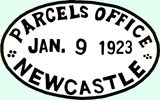 so.N1 (b)(m/d6/s) so.N1 (b)(m/d6/s) |
 so.N1 (c)(s/d6/m) so.N1 (c)(s/d6/m) |  so.P1(s/s/c) so.P1(s/s/c) |  so.S1(s/s/c) so.S1(s/s/c) |  so.W1(s/s/c) so.W1(s/s/c) |
(‡) Should this ‘circle’ mark should be listed in a group of its own?
North Eastern Railway 3 – do (double-border oval)
In the Further Information on the line below the Group Code, we assume that there is always space for 3 ‘lines’ of text (with the top and bottom lines usually curved). When a ‘line’ is blank we annotate its posititon with a dash (–). This Further Information is not part of the Group Code.
 do.B1(s/d5/-) do.B1(s/d5/-) |  do.C1(-/d1/s) do.C1(-/d1/s) |  do.D1(s/d6/-) do.D1(s/d6/-) |  do.E1(s/d6/-) do.E1(s/d6/-) |
 do.H1(s/d6/m) do.H1(s/d6/m) |  do.L1 (a)(-/d1/s) do.L1 (a)(-/d1/s) |  do.L1 (b)(-/d5/s) do.L1 (b)(-/d5/s) |  do.L1 (c)(m/d5/s) do.L1 (c)(m/d5/s) |
 do.N1 (a)(s/d2/m) do.N1 (a)(s/d2/m) |  do.N1 (b)(s/d6/m) do.N1 (b)(s/d6/m) |  do.S1 (‡)(m/d5/sc) do.S1 (‡)(m/d5/sc) |  do.Y1(s/d5/m) do.Y1(s/d5/m) |
(‡) The classification Double Oval refers only to the outline/border (not the inner oval).
North Eastern Railway 4 – srec (single-border rectangle)
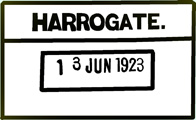 srec.H1(s/d5) srec.H1(s/d5) |  srec.H2(m/c/s) srec.H2(m/c/s) |  srec.H3(s) srec.H3(s) |
 srec.N1 (a)(s/m) srec.N1 (a)(s/m) |  srec.N1 (b)(s/s/m/m) srec.N1 (b)(s/s/m/m) |  srec.S1(s/d5) srec.S1(s/d5) |
2. Railway Company Cancels of the Great Western Railway (GWR)
If a postmark contains a station name, we again annotate the illustration with a Group Code followed by an An (a) suffix (see above).
We start looking at GWR marks with the assumption that we will find similar marks to those we have seen used by the NER. However …
Great Western Railway 1 – X Marks
Straight away we find a quite different type of handstamp: a ‘cross’ (X) cancellation (which is perhaps unique to the GWR), and which we will identify simply as X. This cancellation is sometimes a bit smudged, but is often quite sharp and well defined. It is quite large and can be applied in almost any orientation. It is usually in mauve ink (m), but green ink (g) is also known. This is a ‘dumb’ cancel which contains no useful information, and whose sole purpose is to render the stamp unfit for re-use.
 x (m) x (m) |  x (m) x (m) |  x (g) x (g) |
Great Western Railway 2 – can (CANCELLED)
Here we find another mark not seen on NER stamps. Plain CANCELLED handstamps (with just the single line of text) are known to have been used by a number of railways. The GWR also used such a plain one-line CANCELLED handstamp, but only rarely (listed here simply as Can):
![]() can
can
Instead, the GWR used a 2-line CANCELLED handstamp which included the station name. We annotate such illustrations here as can followed by a suffix An (a) (see above).
 can.A1 can.A1 |  can. B1 can. B1 |  can.C1 can.C1 |  can.L1 can.L1 |
 can.L2 can.L2 |  can.M1 can.M1 |  can.M2 can.M2 |  can.P1 can.P1 |
Great Western Railway 3 – un (unframed)
Like the NER above, the GWR very rarely cancelled stamps by using only an unframed date stamp, and if you find such a cancellation it was probably done in error. Apart from the single line CANCELLED marks noted above, no other unframed line GWR marks are known.
Great Western Railway 4 – rdsq (rounded double-border square)
Here again we find a type of postmark/cancel not used above by the NER – a square with rounded corners (listed here as rdsq). As far as we have seen, these marks always have a double border, and always contain the company initials (G.W.R.) at the top, the date in D Mon YYYY format in the middle, and the station name at the bottom (though this is sometimes on 2 lines). We have therefore dispensed with any Further Information to differentiate these.
After the rdsq Group Code we again use the An (a) suffix (see above).
 rdsq.C1 rdsq.C1 |  rdsq.L1 rdsq.L1 |  rdsq.M1 rdsq.M1 |  rdsq.P1 rdsq.P1 |
Great Western Railway 5 – drec (double-border rectangle)
These rectangular postmarks/cancels always have a double border, and always have three lines containing the text G.W.R., the date (but not always in the same format), and the company name. These are not always in the same position (viz. top, middle or bottom). There is also sometimes a fourth CANCELLED line.
After the drec Group Code we again use the An (a) suffix (see above)
In the Further Information below the Group Code we have adopted much the same explanatory format as was used above for the NER single-border rectangular marks.
 drec.G1(c/m/d6/s)
drec.G1(c/m/d6/s) drec.L1(s/s/d6/c)
drec.L1(s/s/d6/c) drec.L2(c/d6/s)
drec.L2(c/d6/s) drec.W1(c/d5/s)
drec.W1(c/d5/s)
3. Railway Company Cancels of the Caledonian Railway (CR)
If a postmark contains a station name, we again annotate the illustration with a Group Code followed by an An (a) suffix (see above).
Caledonian Railway 1 – un (unframed)
The Caledonian Railway did not generally cancel stamps using only a date stamp. However, date-only CR cancels are known … but only at Glasgow (Central) station. These cancels are always in d5 date format (DD Mon YYYY). Some examples are given here:
You may very occasionally find a Caledonian Railway stamp apparently ‘cancelled’ with just a station name handstamp, but the station name is likley to have been ‘bulk-stamped’ on full sheets of stamps which do not contain a printed station name merely to prevent fraud (rather then to cancel the stamps).
Caledonian Railway 2 – so (single-border oval)
Note that the classification Single Oval refers only to the outline/border (not the inner oval).
 so.D1(s/d5/m) so.D1(s/d5/m) |  so.M1(c/d5/s) so.M1(c/d5/s) |  so.P1(s/d5/m) so.P1(s/d5/m) |
Caledonian Railway 3 (a, b, c) – Diamond-shaped Marks
There are three kinds of Caledonian Railway diamond-shaped marks with a single line border, and we will deal with them individually:
• sd-t: Single-border Diamond (Tall, sharp corners) (fairly common)
• sd-r: Single-border Diamond (Tall, Rounded Corners) (rare)
• sd-w: Single-border Diamond (Wide) (most common)
 sd-t sd-t | 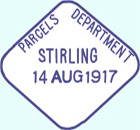 sd-r sd-r |  sd-w sd-w |
There is also a rare Caledonian Railway diamond-shaped mark with a double-line border which we will also deal with separately:
• dd: Double-border Diamond (very rare)
Caledonian Railway 3a: sd-t (single-border diamond, tall, sharp corners)
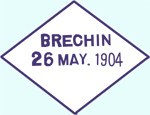 sd-t.B1 sd-t.B1 |  sd-t.G1 sd-t.G1 | 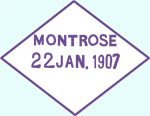 sd-t.M1 sd-t.M1 |
 sd-t.P1 sd-t.P1 |  sd-t.P2 sd-t.P2 |  sd-t.S1 sd-t.S1 |
Caledonian Railway 3b: sd-r (single-border diamond, tall, rounded corners)
These marks are rare, but are known on ordinary parcel stamps and on Express parcel stamps.
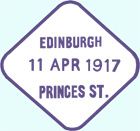 sd-r.P1 sd-r.P1 |  sd-r.S1 sd-r.S1 |
Caledonian Railway 3c: sd-w (single-border diamond, wide)
All of these marks are identical in structure, with the station name on top, the date in d5 format (DD Mon YYYY) in the middle. The bottom is always blank, except where it is used for part of a long station name.
 sd-w.A1 sd-w.A1 |  sd-w.B1 sd-w.B1 |  sd-w.C1 sd-w.C1 |
 sd-w.D1 sd-w.D1 |  sd-w.E1 sd-w.E1 |  sd-w.K1 sd-w.K1 |
The green mark is only known at Alloa, and all known Alloa marks of this kind are green.
Note also the Callender mark, where the date has been inserted upside down.
Caledonian Railway 4 – dd (double-border diamond)
The example given here is the only double-line-border diamond mark seen so far.

dd.S1
Caledonian Railway 5 – srec (single-border rectangle)
 srec.E1 srec.E1 |  srec.G1 srec.G1 | 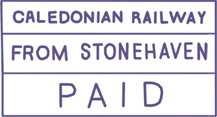 srec.S1 srec.S1 |
Caledonian Railway 6 – drec (double-border rectangle)
The example given here is the only double-line-border rectangle mark seen so far.

drec.L1
Summary & Points to Note
• As far as we know, these railway company postmarks/cancels have not been systematically studied before, so there is plenty of room for collection and investigation. Initially at least, it should be quite cheap to collect and study such marks.
• Like Post Office postmarks, railway company marks are often smudged or mis-shapen.
• The classification system presented above is not definitive and may need to be refined as more information becomes available.
• Even for the railways displayed here, new types of marks and variations of known marks are likely to be found.
If you want contact us, ask a question, or if you would just like to know more,
CLICK HERE to go the the Contact Us page